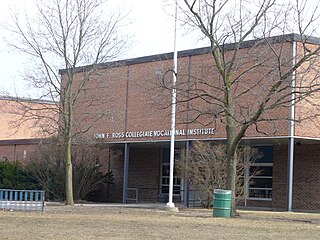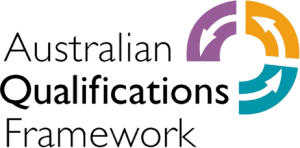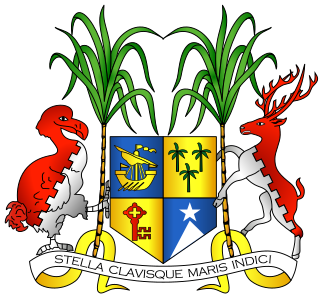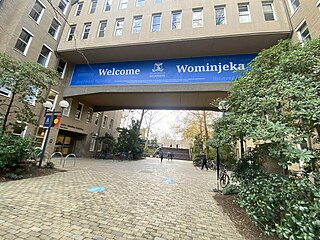Related Research Articles

Education in Australia encompasses the sectors of early childhood education (preschool) and primary education, followed by secondary education, and finally tertiary education, which includes higher education and vocational education. Regulation and funding of education is primarily the responsibility of the States and territories; however, the Australian Government also plays a funding role.

Vocational education is education that prepares people for a skilled craft. Vocational education can also be seen as that type of education given to an individual to prepare that individual to be gainfully employed or self employed with requisite skill. Vocational education is known by a variety of names, depending on the country concerned, including career and technical education, or acronyms such as TVET and TAFE. TVE refers to all forms and levels of education which provide knowledge and skills related to occupations in various sectors of economic and social life through formal, non-formal and informal learning methods in both school-based and work-based learning contexts. To achieve its aims and purposes, TVE focuses on the learning and mastery of specialized techniques and the scientific principles underlying those techniques, as well as general knowledge, skills and values.

Tertiary education fees in Australia are payable for courses at tertiary education institutions. Responsibility for fees in vocational education and training (VET) rests primarily with the state and territory governments, while fees policy in higher education is largely controlled by the Commonwealth Government.

Charles Darwin University (CDU) is an Australian public university with a main campus in Darwin and eight satellite campuses in some metropolitan and regional areas. It was established in 2003 after the merger of Northern Territory University, the Menzies School of Health Research, and Centralian College.
Northern College of Applied Arts and Technology, commonly known as Northern College, is a college of applied arts and technology in Northern Ontario, Canada. It is partnered with private Pures College of Technology in Midland and Scarborough. The college's catchment area extends across 58,000 square miles or 150,200 square kilometres. More than 65 communities within Northeastern Ontario are served by four campuses located in Timmins, Kirkland Lake, Moosonee, and Temiskaming Shores (Haileybury). Annual enrolment is approximately 1,500 full-time students. Annual part-time and continuing education enrollment exceeds 11,000 students. Northern College is also home to the Haileybury School of Mines, which predates the college and was founded in 1912.

St. Lawrence College (SLC) is a College of Applied Arts and Technology with three campuses in Eastern Ontario, namely Brockville (1970), Cornwall (1968) and Kingston. It is affiliated with private Alpha College of Business & Technology in Toronto and Canadian College in Vancouver. As of May, 2024, St. Lawrence College is no longer accepting new admissions to programs offered at their partner colleges. The population of St Lawrence College and it's affiliates includes a large contingent of international students. The college processed 5,421 international study permits in 2023.

The Australian Qualifications Framework (AQF) specifies the standards for educational qualifications in Australia. It is administered nationally by the Australian Government's Department of Industry, with oversight from the States and Territories, through the Standing Council of Tertiary Education Skills and Employment. While the AQF specifies the standards, education and training organisations are authorised by accrediting authorities to issue a qualification.

TAFE South Australia provides vocational education and training in the state of South Australia.
TAFE NSW is an Australian vocational education and training provider. Annually, the network trains over 500,000 students in campus, workplace, online, or distance education methods of education. It was established as an independent statutory body under the TAFE Commission Act 1990. The Minister for Regional Development, Skills and Small Business is responsible for TAFE NSW.
A registered training organisation (RTO), in Australia, is an organisation providing Vocational Education and Training (VET) courses to students, resulting in qualifications or statements of attainment that are recognised and accepted by industry and other educational institutions throughout Australia.
Melbourne Polytechnic, formerly NMIT, is an institute of higher education and vocational education (TAFE) located in Melbourne, Australia that has been operating since around 1910.

Bow Valley College is a Canadian public, board-governed college located in Calgary, Alberta, operating as a comprehensive community institution under the Post-Secondary Learning Act of Alberta. The branch campuses are: Airdrie, Banff, Cochrane, Okotoks, and Strathmore. Bow Valley College is a member of the Alberta Rural Development Network and Colleges and Institutes Canada.

Education in Mauritius is managed by the Ministry of Education & Human Resources, which controls the development and administration of state schools funded by government, but also has an advisory and supervisory role in respect of private schools. The Tertiary education is maintained by the Ministry of Tertiary Education, Science, Research and Technology. The government of Mauritius provides free education to its citizens from pre-primary to tertiary levels. Since July 2005, the government also introduced free transport for all students. Schooling is compulsory up to the age of 16. Mauritian students consistently rank top in the world each year for the Cambridge International O Level, International A and AS level examinations. Among sub-Saharan African countries, Mauritius has one of the highest literacy rates. The adult literacy rate was at 91.9% in 2022. According to the 2022 census, the proportion of people with higher education has increased to 8.8%. Mauritius was ranked 57th in the Global Innovation Index in 2023, 1st in Africa.
The Commonwealth Register of Institutions and Courses for Overseas Students (CRICOS) is a register formed under the Education Services for Overseas Students (ESOS) Act 2000. It maintains a list of institutions, and courses, which have been granted permission by states and territories, to educate overseas students. It is a Federal framework under the authority of state and territory jurisdiction, and providers must register through these agents to legally educate and train international students. CRICOS, in conjunction with other federal and state/territory bodies and legislation, provides strict guidelines for institutions, accepts and/or declines registrations, monitors registered institutions’ compliance and ensures financial capability and stability.

Tertiary education in Australia is formal education beyond high school in Australia, consisting of both government and private institutions and divided into two sectors; Higher Education and Vocational Education and Training (VET) provided by government-owned TAFEs & private Registered Training Organisations (RTO). Australian Qualifications Framework (AQF), the Australian national education policy, classifies tertiary qualification into 10 levels: level 1 to 4 vocational certificates ; level 5 & 6 undergraduate diploma and advanced diploma; level 6 associate degree; level 7 bachelor degree, level 8 bachelor honours degree & graduate certificates and graduate diplomas; level 9 for master's degree; and level 10 PhD. Most universities are government owned and mostly self-regulated. For other institutes there are two national regulators for tertiary education for registration, recognition and quality assurance of both the "provider institutes" as well as the "individual courses" provided by the providers. Tertiary Education Quality and Standards Agency (TEQSA) regulates institutes which provide education from level 5 or above. Australian Skills Quality Authority (ASQA) regulates institutes which provide education from level 1 to level 6.
Student migration is the movement of students who study outside their country of birth or citizenship for a period of 12 months or more. During the period of globalization, the internationalisation of higher education increased dramatically and it has become a market driven activity. With the rapid rise of international education more and more students are seeking higher education in foreign countries and many international students now consider overseas study a stepping-stone to permanent residency within a country. The contributions that foreign students make to host nation economies, both culturally and financially has encouraged major players to implement further initiatives to facilitate the arrival and integration of overseas students, including substantial amendments to immigration and visa policies and procedures. Institutions are competing hard to attract international students at a time when immigration policies in leading destinations like the US and the UK are not enabling transition to work visas.

Higher education system in India includes both public and private universities. Public universities are supported by the union government and the state governments, while private universities are mostly supported by various bodies and societies. Universities in India are recognized by the University Grants Commission (UGC), which draws its power from the University Grants Commission Act, 1956. The main governing body is the University Grants Commission, which enforces its standards, advises the government, and helps coordinate between the center and the state. Accreditation for higher learning is overseen by various autonomous institutions established by the University Grants Commission (UGC).

Australia ranked third in top study abroad destinations with a total market value of over 5 billion AUD generated by international students in 2018. In 2023, 786,891 international students were enrolled in educational programs in Australia, which was 27% higher than the previous year. In 2024 this is forecasted to increase again by 18%. They come to gain a high-quality education, possibly immigrate, or to experience a different life. Each year, many new international students will enroll in Australian courses and add to the already significant international student body around the country.

The United Kingdom is among the world's most popular destinations for international students, regularly placing within the top three countries for hosting international students alongside the United States and Australia. Data from the Higher Education Statistics Agency indicates that students from the three countries of India, China, and Nigeria together account for around 53% of all international students enrolled at higher education institutions in the UK.
Canada rose to the third most popular destination for international students in 2022, following the United States and United Kingdom. It had been the fourth most popular destination in 2019. Canada was reported to have 1,040,985 international students at the end of 2023, a 29% increase over 2022, accounting for more than 2% of the country's population. Other sources report that number as an underestimate, the true number being potentially as high as two million.
References
- 1 2 3 4 5 6 7 8 Lucas, Clay (19 August 2023). "Rise of the ghost college: Thousands of students are enrolled in the city but they aren't in class". The Sydney Morning Herald. Retrieved 20 December 2024.
- 1 2 3 Bolton, Robert (21 October 2018). "Ghost schools and no teachers, the vocational education and training rort". Australian Financial Review.
- 1 2 3 Nixon, Christine (31 March 2023). "Rapid Review into the Exploitation of Australia's Visa System" (PDF). Australian Government. Retrieved 20 December 2024.
- 1 2 3 4 Joint Standing Committee on Foreign Affairs, Defence and Trade (October 2023). "Inquiry into Australia's tourism and international education sectors" (PDF). Parliament of Australia. Retrieved 20 December 2024.
- 1 2 3 Braithwaite, Valerie (January 2018). "All eyes on quality: Review of the National Vocational Education and Training Regulator Act 2011 report". Australian Government. Retrieved 20 December 2024.
- 1 2 Giles, Andrew. "Over 150 ghost colleges axed" . Retrieved 20 December 2024.
- 1 2 3 "Australia's 'ghost college' crackdown: Hundreds of providers shuttered or warned". SBS News. Australian Associated Press. 20 August 2024.
- 1 2 3 McHugh, Finn (4 October 2023). "It's been a week of major migration changes. Here are the key takeaways". SBS News. Retrieved 20 December 2024.
- ↑ Thompson, Angus (27 December 2023). "Indian students rejected as Australia cracks down on 'ghost colleges'". The Age. Retrieved 20 December 2024.
- 1 2 Farrell, Paul (6 November 2019). "How police busted a multi-million-dollar 'ghost college' scam". ABC News. Retrieved 20 December 2024.
- ↑ Arora, Avneet; Singh, MP (22 November 2019). "'Private ghost colleges in Australia are targeting students from India'". SBS News. Retrieved 21 December 2024.
- ↑ Visentin, Lisa (27 August 2023). "Further crackdown coming for VET sector to target 'ghost colleges'". Sydney Morning Herald.
- 1 2 Lucas, Clay (5 June 2023). "Leaked memos reveal international students rorting dual-study loophole". The Age.
- ↑ Bachelard, Michael; McKenzie, Nick (14 May 2023). "'Grotesque abuses': Secret review of migration system scathing of failures". The Age. Retrieved 20 December 2024.
- ↑ Bachelard, Michael; McKenzie, Nick; Ballinger, Amelia (23 July 2023). "Brought to Australia as a 'student', Henry was made into a slave". The Age. Retrieved 20 December 2024.
- ↑ Bali, Meghna; Patidar, Som; Sadler, Rahni (17 September 2024). "Scams shattering Indian students' dreams of studying in Australia". ABC News. Retrieved 20 December 2024.
- 1 2 "International student monthly summary and data tables". Australian Government. Retrieved 20 December 2024.
- ↑ Norton, Andrew (28 August 2024). "The government will cap new international students at 270,000 in 2025. But this number may not be reached". The Conversation. Retrieved 20 December 2024.
- ↑ Hoang, Sam; Hurley, Peter (1 July 2024). "As student visa fees jump to $1,600, Australia is refusing more applications than ever". The Conversation. Retrieved 20 December 2024.
- ↑ Truu, Maani (17 December 2024). "University sector expects Ministerial Direction 107 to be replaced with 'fairer' approach to student visas". ABC News. Retrieved 20 December 2024.
- 1 2 Lucas, Clay; Groch, Sherryn (26 August 2023). "'Ghost colleges' loophole closed in student work crackdown". Sydney Morning Herald. Retrieved 20 December 2024.
- ↑ Ley, Sussan; Henderson, Sarah (16 September 2024). "Labor must answer questions about student cap process and ghost college lie" . Retrieved 20 December 2024.
- ↑ White, Daniella (1 December 2024). "Colleges shut, thousands of students lose qualifications in fake diploma crackdown". Sydney Morning Herald. Retrieved 20 December 2024.
- ↑ Chung, Frank (26 November 2024). "Fake students complain to Indian newspaper after Australian 'ghost college' crackdown". No. News.com.au. Retrieved 20 December 2024.
- ↑ van Onselen, Leith (26 August 2024). "Will Australia deport the student visa rorters?". MacroBusiness. Retrieved 20 December 2024.
- 1 2 Chung, Frank (30 August 2024). "Calls to deport visa rorters after 'ghost college' crackdown". News.com.au. Retrieved 20 December 2024.
- ↑ Hare, Julie (11 August 2024). "Crackdown on overseas students triggers rise in refugee applications". Australian Financial Review. Retrieved 20 December 2024.